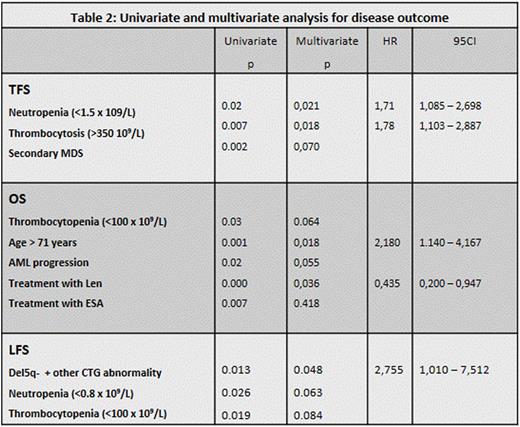Abstract

Introduction: Myelodysplastic syndrome with del5q (MDSdel5q) is the only cytogenetically defined MDS category recognized by WHO in 2001, 2008 and 2016 and is defined as a MDS with deletion on the long arm of chromosome 5 and less than 5% of blast cells in bone marrow. It is known that for patients with MDSdel5q and transfusion dependence (TD), Len (LEN) is the first choice of treatment. However, data regarding factors that may impact on the development of TD or disease evolution in patients diagnosed without TD are scanty. In our study a retrospective multicenter analysis on patients with low-int 1 MDSdel5q without TD at diagnosis has been performed in order to answer these questions.
Patients and methods: We performed a multicenter collaborative research from the Spanish (RESMD) and German MDS registries. Data from 153 low risk MDSdel5q without TD at diagnosis were retrospectively analyzed.
Statistical analysis: Data were summarized using median, range, and percentage. The event of TD was defined as the development of TD according to the IWG criteria (2006) and/or the beginning of a treatment which could modify disease course (LEN or ESA). Transfusion or treatment free survival (TFS), overall survival (OS) and leukemia free survival (LFS) were measured from diagnosis to TD or treatment, the first occurred (or to last follow up if none), last follow up or death from any cause and evolution to AML, respectively. TFS, OS and LFS were analyzed using the Kaplan Ð Meier method. The Log-rank test was used to compare variables and their impact on survival for univariate analysis.Multivariate analysis was performed using Cox's proportional hazards regression model. For comparison of Kaplan Meier curves the long rank test was used, with statistical significance with p<0.05. Statistical analysis was performed using SPSS 20.0.
Results: Main clinical and biological characteristics were summarizing in table 1. From the total of 153 patients, finally 121 were evaluable. During the study 56 patients (46.2%) became in TD and 47 (38.8%) did not develop TD but received a modified disease course treatment. In this sense, most of the patients developed relevant anemia regarding those data (103 out of 121 patients, 85%). Median time to TD or treatment (TFS) was 20 months (1-132) from diagnosis. Secondary MDS (p=0.02), thrombocytosis (>350 109/L) (p=0.007), and neutropenia (<1.5 x 109/L) (p=0.02) were associated with poorer TFS. Thrombocytosis and neutropenia retained statistical significance in the multivariate analysis (Table 2). Among the TD patients (N=56), 42 (75%) received treatment: 28 LEN, 7 ESA and 7 other treatments. Among patients that did not develop TD (N=65), 47 (72.3%) received treatment before TD development: 16 LEN, 28 ESA and 3 other treatments.
In order to know the evolution of these patients, survival analysis was performed. Median follow up was 58.9 months among alive patients and 57% of them were alive at the time of the last follow up. Estimated OS at 2 and 5 years was 94% and 64%. Regarding Univariate analysis, platelet <100 x 109/L (p=0.03), patients older than 71 years (p=0.001), and progression into AML (p=0.02) were associated with poorer OS. On the contrary, patients who had received treatment showed better OS (p<0.0001). This benefit is more evident among patients receiving LEN, median OS for patients receiving LEN, ESA/other treatments and not treated group was 137 months (CI 95%: 59,4 -215,5), 99,3 months (CI 95%: 46,6 -152) and 57,9 months (CI 95%: 38,2 -77,6), respectively, p<0.0001 (Figure 1). In the multivariate analysis, patients older than 71 years and LEN treatment retained the statistical significant impact on OS (Table 2). Twenty-eight patients (23%) progressed into AML, median time to AML was 35 months (5-122). When univariate analysis was performed, variables with adverse impact on LFS were platelets <100 x 109/L(p=0.019), neutropenia < 0.8 x 109/L (p=0.026), an additional cytogenetic abnormality (p=0.013) while treatment with LEN had a favorable impact (p=0.035). In the multivariate analysis only the presence of additional cytogenetic abnormalities retained statistical significance (Table 2).
CONCLUSIONS: Most of the patients with low risk del(5q) MDS and no TD at diagnosis developed symptomatic anemia very early after diagnosis (20 months). Carefully monitoring should be stablished in order to detect this time point. Outcome of this subset of patients could improve after target therapy.
Del Cañizo:Celgene: Membership on an entity's Board of Directors or advisory committees, Research Funding, Speakers Bureau; Novartis: Membership on an entity's Board of Directors or advisory committees, Research Funding, Speakers Bureau; janssen: Research Funding; Astex: Membership on an entity's Board of Directors or advisory committees. Díez Campelo:celgene: Membership on an entity's Board of Directors or advisory committees, Research Funding, Speakers Bureau; Novartis: Membership on an entity's Board of Directors or advisory committees, Research Funding, Speakers Bureau; Janssen: Research Funding; Astex: Membership on an entity's Board of Directors or advisory committees.
Author notes
Asterisk with author names denotes non-ASH members.

This icon denotes a clinically relevant abstract




This feature is available to Subscribers Only
Sign In or Create an Account Close Modal